Mauritius and Reunion islands beckon with beauty and history
English captain Matthew Flinders was held captive on Mauritius and didn’t want to leave. Neither will you.
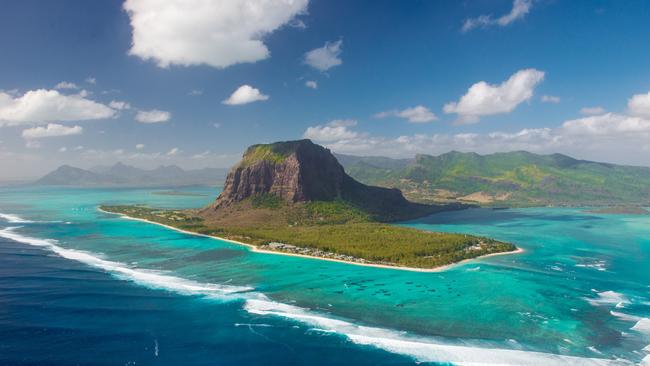
Who could resist a red telephone box from which you can call an international landline at no charge? Not me. I surprise my friend at her desk in Melbourne. “I think this is the only time in my life I’ll get a call from Mauritius,” she says, in a rare gush.
I get it. Even in the 21st century, Mauritius is as exotic as a whiff of vanilla. To me, its name is a blend of “more” and “delicious”, and when I say it out loud, it’s as soothing as the breeze jiggling palm fronds or saltwater licking the sand. There are countries further from Australia and others more difficult to reach but few emanate the romance of this multicultural Indian Ocean island nation. No wonder honeymooners flock in droves.
I can’t wait to drink it in, this unknown land, but enlightenment is delayed as darkness shrouds the outpost when my plane lands. It’s an hour’s drive to Le Morne in the island’s southwest and the headlights illuminate little, maintaining the mystique until morning. My driver says Mauritians are more about family life than nightlife; his words roll out the window and bounce down empty streets. Mauritians, I discover, are delighted to be asked about their families but they’re also interested in you. The country’s economy has long revolved around tourism and I can see why visitors would want to return for an extra helping of Mauritian warmth and charm. Upon arrival at LUX Le Morne, bug-eyed after travelling from Australia’s east coast, I’m swiftly ushered to my suite so I can recover from the journey.
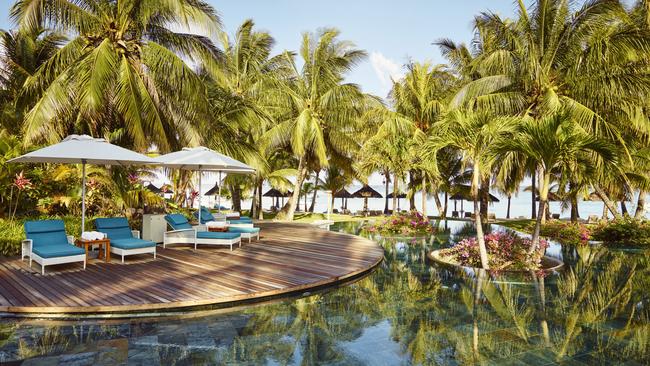
Sunrise reveals the 149-room resort is snuggled at the foot of Le Morne mountain, a dramatic monolith that looms large in the island’s history as a refuge for runaway slaves who settled in its caves and on the summit. You can hike the 556m nub but I cycle past the World Heritage-listed landmark with Laurent Marrier d’Unienville from Electro Bike Discovery. We cruise along the south coast, admiring the acrobatics of kite-surfers taking advantage of the steady trade winds and inspecting the Matthew Flinders commemorative sculpture (Laurent’s ancestors have a Flinders connection). For lunch, we stop at a photogenic pink and aqua-painted roadside stall for roti chaud (warm Indian flatbread) wrapped around vegetable curry, a snack that costs only a few rupees. It’s such a delightful peek into village life that I vow to return for a cycling holiday one day.
There’s no shortage of things to do in this corner of the island. A five-minute stroll from the resort is the Slave Route Monument, a collection of poignant sculptures illuminating the tragic history of the mountain from which fugitive slaves leapt to their death rather than face capture. I venture up to Rhumerie de Chamarel, 14km from LUX Le Morne. As I admire the distillery’s manicured gardens and pops of pink bougainvillea, I taste-test its rums (bottles of the gold and spice varieties accompany me home).
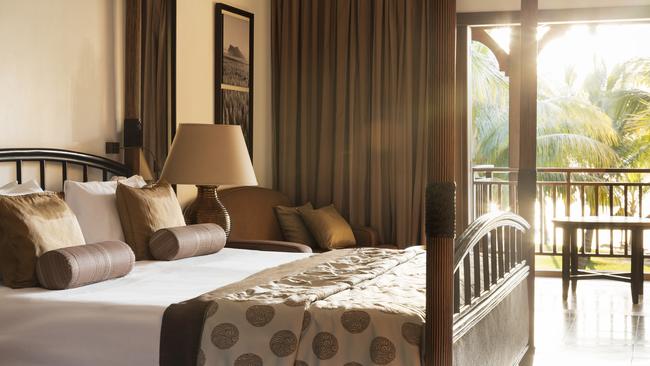
The island’s sugar is celebrated in other ways. At the resort, any coffee order comes with a selection of six sugars, ranging from dark muscovado to golden granulated. I get so carried away at my rum tasting that I almost miss lunch on the deck at Restaurant Le Chamarel, a perch offering panoramic views of the lagoon. I plunge into those every-shade-of-blue waters another day, swimming among pods of spinner dolphins that attract swarms of tourist boats.
My favourite plunge is the one I take with the resort’s guest experience manager, Vik Chuttur. We wriggle into wetsuits, flippers and snorkels, and search among the corals for sea urchins as the sun slides towards the horizon. Vik bags eight of the spiky creatures but, back ashore, I hesitate before tasting the delicacy. I’ve tried sea urchins as a sushi topping, but found their flavour intense. Different story, however, when they’re scraped straight from their briny shell, drenched in lemon juice and chased with champagne. LUX makes a point of surprising guests with unexpected touches such as the free “phone home” box. Those who happen to be wandering the shoreline at this golden-hued moment are encouraged to come on over and share in the gourmet experience.
Too soon, it’s time to swap islands, but not before the attentive concierge notices my early departure means I’m missing breakfast and insists on packing a snack box.
Reunion Island is just 200km from Mauritius but the two are like chalk and, well, fromage. Reunion, where the citizens mean France when they refer to the mainland, feels more formal and well-to-do than its neighbour. But despite the Parisian-style sophistication, Reunion struggles with an issue of the most primal kind. Following a series of fatal shark attacks, swimming is permitted only in a few protected areas such as the lagoon fronting LUX Saint Gilles on the west coast. The resort’s lifeguard assures me there are no sharks but I prefer to play it safe, paddling a transparent kayak over the pretty corals and schools of fish. (After returning to Australia, there’s news a 2m shark was spotted in the lagoon.)
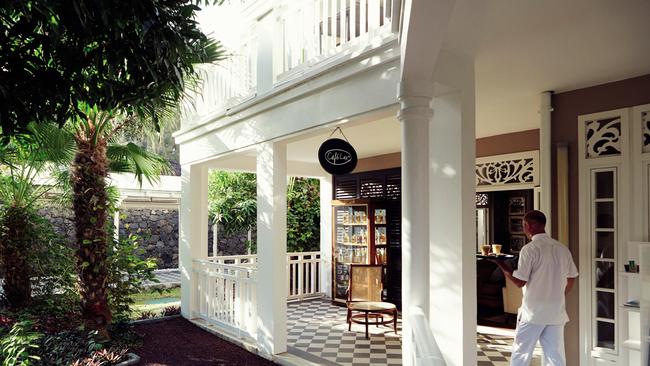
Luckily, Reunion’s dramatic World Heritage-listed interior makes you forget beaches quick-smart. Mauritius’s highest point is 828m above sea level but Reunion’s geography tops out at an awe-inspiring 3069m. Setting off with Corail Helicopteres, I strap in for the ride of my life, swooping and looping up and over a trio of cliff-rimmed cirques. We buzz over volcanoes and barren lava fields and spin on a dime at the end of a canyon to take in a cascade of waterfalls tumbling over sheer rockfaces. It’s astonishing that Jurassic Park wasn’t filmed here.
The geography is so extreme that one cirque, Mafate, remains roadless. It’s possible to drive into Cirque de Cilaos, although it’s only for those whose constitution can cope with the twists and turns of a corkscrew road. Guide Nicolas Barniche, sporting a jaunty cap and scarf arranged just so, points out a farmer tending his fields of lentils before we explore the village of Cilaos where Creole architecture lines the streets. I delight in the homes’ wooden shutters, pastel colour schemes and lambrequin-lined rooflines that resemble decorative frosting. Cilaos is our lunch stop. Curry is a favourite Creole dish, says Barniche, but “we never put chilli in our meal ... it’s always on the side”. Chez Lucay’s menu showcases the local lentils, paired with smoked pork, smoked duck leg or fresh sausages. We add scoops of rice and, for me, Dodo beer.
After returning to the resort, it’s time for a dose of sound therapy, courtesy of one of LUX’s expert-led workshops, available across its resort portfolio. With long locks and a gaze as deep as the Indian Ocean’s Diamantina Trench, Mauritian wellness therapist Bhavnath looks like a guru from central casting. He hands out a list of blissful chants and, with gentle encouragement and the strumming of a guitar, it’s not long before he persuades us to raise our voices to sing, “We are one with the infinite sun ... forever, forever and ever.” I’m asked to pick out a chant for us all. There’s a familiar title among the 98 selections (John Lennon’s Imagine) but I plump for Number 14: “The beauty that surrounds you/ the love that surrounds you/ brings joy to my heart.”
I’m quite possibly the world’s least spiritual person but, as I bounce out the door feeling more joyful, I have to admit this guy might be on to something. Love and hugs, Bhavnath. Perhaps I’ve seen, or heard, the light.
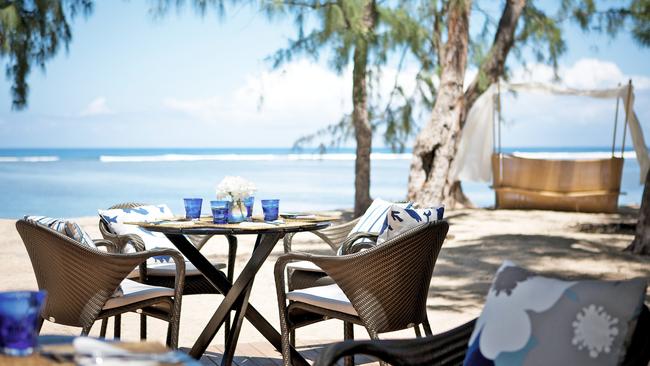
MORE TO THE STORY
In 1803, Captain Matthew Flinders was England-bound after his circumnavigation of the continent now known as Australia when he dropped anchor at Ile de France (Mauritius). Unaware hostilities had resumed between France and Britain as part of the Napoleonic Wars, Flinders needed to repair the leaky Cumberland. This fateful stop would keep him hostage on the island for the next six and a half years. But his “imprisonment” was hardly harsh. At first he stayed in the capital, Port Louis, before his friends convinced the governor to allow him to move to the cooler interior highlands, where he cultivated a wide circle of society pals and enjoyed life so much he was regretful when ordered to leave in 1810. He wrote to a friend that he hoped he’d return but never did.
A monument to Flinders was erected near Baie du Cap in 2003, marking the bicentenary of his arrival at the spot. The bronze bas-relief depicts a uniformed Flinders holding a quill above a map, on which Australia features prominently, while a cat watches from a windowsill. The inscription partly reads: “His book, A Voyage to Terra Australis, which gave the Australian continent its name, was published in 1814, the day before he died.”
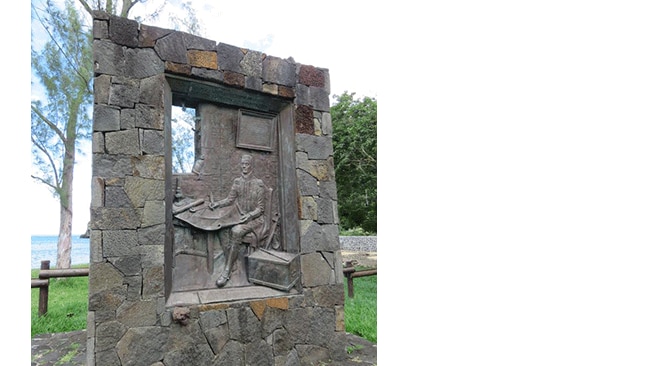
IN THE KNOW
LUX Le Morne is one of three LUX resorts on Mauritius. From $US195 ($258) a person a night twin-share with breakfast; for half-board, add $US61 a person a night. LUX Saint Gilles on Reunion Island has a sister property, LUX Sud Sauvage, opening next year. From $US149 a person a night twin-share with breakfast; for half-board, add $US53 a person a night. A discount applies to combination stays at two or more LUX properties in Mauritius, Reunion Island, Maldives and Turkey. Air Mauritius flies direct to Mauritius from Perth; connect from other Australian cities with Virgin Australia.
More: luxresorts.com
LUX runs regular expert-led workshops at its resorts. Topics range from how to make kombucha to DIY Chinese medicine techniques. From December 15-23, Michelle (Mitch) Lackenby, of Melbourne’s Paperazzi Design Studio, will lead Japanese bookbinding workshops at Mauritius’s LUX Le Morne, Belle Mare and Grand Gaube resorts; $US40 a session.
Katrina Lobley was a guest of LUX Resorts & Hotels.
